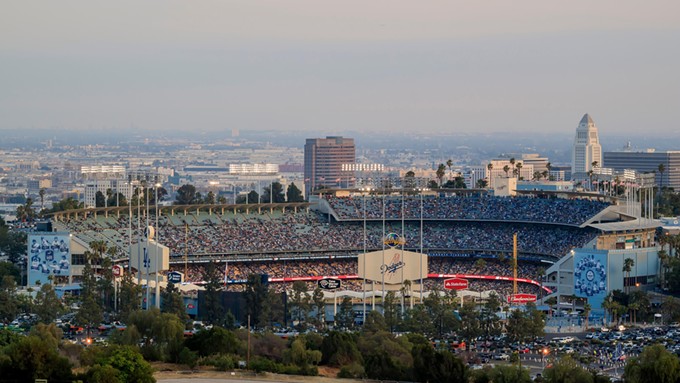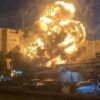
For many of us who grew up as sports fans in Los Angeles, Dodger Stadium was special. Oh, there was the Memorial Coliseum, which had been built in the 1920s in advance of the 1932 Olympics, but it always felt cavernous and ancient. (Who knew that it would make it to its 100th birthday in 2023?) The Lakers played in the Sports Arena, which was a dump; then at the Fabulous Forum, which always looked and felt like it had been designed by and for drug-addled sex workers; and finally, in Crypto.com Arena. If you play in a venue named for Bitcoin, you have officially sold your soul.
Ah, but Dodger Stadium … it was new and shiny and clean. Just about every family in Los Angeles in the 1960s had members who had come from somewhere else. And you would hear them extolling the virtues of ballparks in other parts of the country.
“Well, it’s certainly no Wrigley Field.” And thank God for that. Who wants a ballpark where you can only play day games?
“Yeah, but what about Fenway Park?” A malformed disaster that insults the game played within and, for that matter, architecture as a whole.
“I love Yankee Stadium.” Yankee Stadium is OK, but they have one big problem. The Yankees play there.
No, Dodger Stadium was the standard. We loved everything about the place — the cheap tickets for the left-field bleachers, the smell of the grass, the taste of the legendary Dodger Dogs. I even got to pitch a high-school baseball game in Dodger Stadium. It felt like heaven … but nothing like Iowa.
But, it was also in high school that I began to learn of some of the ugly history of the metropolis in which we were growing up. Orson Welles once referred to it as “a bright and guilty place.”
One of my high school history teachers invited Dr. Julian Nava to speak to our class. Nava would later become the first Hispanic American to serve as U.S. ambassador to Mexico, but at the time he was the first Latino to serve on the Los Angeles Unified School District Board of Education.
Nava was born and raised in East Los Angeles. As a teenager, he personally witnessed the Zoot Suit Riots, in which Navy sailors, in LA waiting to ship off to the Pacific Theater in World War II, would roam the streets of East LA looking for “greasers in Zoot suits” to beat up. The Navy would actually bus sailors to East LA so they could blow off steam before shipping out.
Meanwhile, the crooked LA cops (was there any other kind back then?) would either stand by or actively encourage the beatings.
He then told of how he witnessed a Zoot suit guy get jumped by five or six sailors who beat him unconscious and then took his girlfriend into the alley. (That’s how he described it; he left it at that.)
After we had caught our breath, Nava continued, reminding us that not all major crimes are violent. He asked us how many of us knew where Palo Verde, Bishop and La Loma were. None of us did. Those were the names of three small barrios in an area nestled between the San Gabriel Mountains and Downtown LA.
Those neighborhoods were known collectively as Chavez Ravine.
(He pronounced the first syllable correctly, as in chacha dancing. By that time, I and millions of other people had been trained to refer to it as Shuh-vez Ravine, the site of Dodger Stadium.)
In the 1950s, the city of Los Angeles bulldozed the barrios, claiming to be doing so to build affordable housing. It was already affordable to the 1,800 or so families living there. But they were forcibly evicted, and their houses razed. No affordable housing was ever built. Instead, the 300 or so acres were purchased by the Dodgers, who moved to LA from Brooklyn. City fathers swore that it was just a coincidence.
Legendary guitarist Ry Cooder grew up in Santa Monica and was old enough to know what was going on when the shady deal was going down. He wrote and performed a gut-wrenching homage to the bulldozed barrios in his 2005 album “Chavez Ravine.” In the main song from the album, the singer, perhaps standing in for one of the former residents of La Loma, said, “Second base, right over there, I see grandma in her rocking chair. Watching linens flapping in the breeze, and all the fellows choosing up teams.
“And if you want to know where a local boy like me is coming from … third base, Dodger Stadium.”
Now, after more than 60 years, it looks like something might get done about the horrible injustice. There is a bill in the California Legislature seeking reparations for the families (and/or their descendants) who were forcibly removed during that terrible time. In a perfect world, they should get the land back. In the real world, they’ll probably get a lot of money, but whatever the amount, it will be too little and too late.
If it were up to me, I would insist that as a part of the deal, from here on until forever, everyone associated with the Dodgers — from TV announcers down to peanut vendors — will use the proper pronunciation of “Chavez.”


